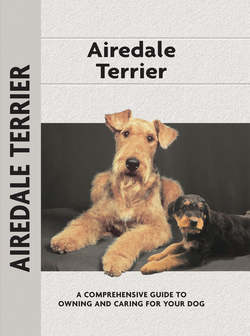Читать книгу Airedale Terrier - Bardi McLennan - Страница 7
На сайте Литреса книга снята с продажи.
A CLEVER SOLUTION
ОглавлениеIt wasn’t long before some bright lads hit upon the idea of mating the gameness of the terrier with the aquatic ability of the hound as the answer to extending their sport. No doubt they also reasoned that one or two such offspring could be kept at home as were their small terriers, rather than requiring the large kennel facilities needed for packs of Otterhounds. Wilfred Holmes is credited with having made the first such cross of hound and terrier in 1853.
At this point I would like to hypothesize. We know the Black and Tan Terrier (whether you wish to call it English or Welsh) was the common terrier in the area. Therefore, would not the Welsh Harrier have been an obvious choice for a cross to obtain slightly more leg and the strength to work in water? In his book Hounds of the World, Sir John Buchanan-Jardine, Bt. MFH, MBH, describes the Welsh Hound, or Harrier, of the 1800s as black and tan or red with rough or wire hair, and smaller than its English cousins. He adds this, which would indicate a perfect trait to cross with a terrier: “(Welsh Harriers) hunt in a more independent style, taking nothing for granted and relying mostly on their own individual efforts.” This was (and is) contrary to the pack hunting style of the English hounds and of the Otterhounds. Then there is the suspicion put forth by Otterhound authorities that the Welsh Harrier is in their ancestral heap!
This black-saddled Harrier hails from the UK in the 1920s.
The extinct Black and Tan Terriers, shown in this 1881 drawing, were common to the area from which the Airedale emanated and are believed to have contributed to the development of many modern terriers.
So we have the wire-coated Welsh Terrier, whose coloration was always black and tan or red and so affirmed in writings of the 1400s. We have the harsh-coated Welsh Harrier, always black and tan or red, but smaller than the Otterhound, which at that time rose to 27 inches (68.5 cm) and weighed as much as 120 lb (54.46 kg)! The weight of the Waterside or Bingley Terrier, as the Airedale was first known, averaged 35–45 pounds (15.9–20.44 kg). Today’s Airedale weighs about 60 pounds (27.2 kg). Now then, were the first hound crosses the Welsh or the Otter? We shall never know!
These first Airedale breeders were intent on the results being nothing more or less than a terrier. What of the “other terriers” frequently mentioned as outcrosses used to eliminate what were considered to be undesirable hound characteristics, such as heavy low-set ears, rounded skull, light eyes, slow hound-like gait and soft woolly coat? (These atavistic faults, by the way, appear from time to time in Airedales to this day.) It is difficult to imagine just how the Bull Terrier (one of those cited) would have corrected these matters, but it might have contributed substance. The Black and Tan Terrier had originally been selected for its drive, tenacity and punishing jaws, so the Bull Terrier was not needed for those attributes. Despite the geographic proximity and the fact that these breeds were not then what we see today, introducing the Dandie Dinmont Terrier would seem an unlikely choice to produce the desired coat, color or ear type. Some records of the day lay claim to such mixes, while others refute it.
The Dandie Dinmont Terrier is a questionable possible addition to the genealogy of the Airedale Terrier.
CLASS CONFUSION
The English Kennel Club’s Stud Book was published in 1874 to register dogs by breed, but problems with breed classifications persisted. In 1890, for example, at Crufts, there was one class listed that wasn’t for any breed at all! Class #220 was for “Stuffed dogs, or dogs made of wood, china, etc.” This may have been the forerunner of the dog-show concessionaire.
As late as 1930, a noted writer dismissed the Airedale breed as rather useless, saying, “Their coats are not heavy enough for them to act as retrievers in cold weather and their noses are not good enough for them to follow cold trails.”
Other observers at the time held an opposing view. One commented on the Airedale’s exceptional capability “not only to hunt vermin but also to hunt game and to retrieve it as well, as he has a very keen nose and is a remarkably good water dog.” As time went on, this latter view prevailed and holds today.
